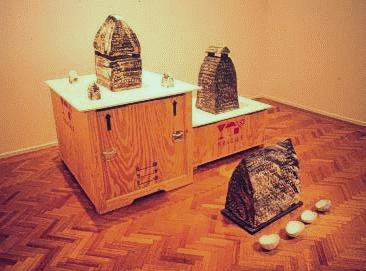How Clay Speaks for Neville Assad
Source
'How clay speaks for Neville Assad' Artlink 11, 59 (1991)
 The
alphabet was invented, so they say, in Lebanon. To some Lebanese, their
country represents an uninterrupted link with the birth of human history.
Non-aboriginal Australians, by contrast, share stories of interrupted
family ties, of exile and forgetting. How then do these Lebanese relate
to life in Australia?
The
alphabet was invented, so they say, in Lebanon. To some Lebanese, their
country represents an uninterrupted link with the birth of human history.
Non-aboriginal Australians, by contrast, share stories of interrupted
family ties, of exile and forgetting. How then do these Lebanese relate
to life in Australia?
Recently at Artspace in Sydney a forum was held on the subject of ‘Lebanon is Sydney’. A second generation Lebanese writer who spoke, Frank Coorey, claimed that during their stay in Australia, Lebanese families undergo an inter‑generational transformation from merchant class to contemplative class: the children of parents who’ve worked hard to establish themselves in a new country give birth to types who are more at ease to reflect upon where they are.
Neville Assad is a second‑generation Lebanese ceramicist and his life can partly be read as an example of Coorey’s theory. Assad tells a story about his career which straddles the two worlds in which his life can be read. His father and mother came to Adelaide in the 1920s. They eventually ran a dairy farm in South Australia and adopted Australian ways ‑ the father joined the army. Though under pressure to take over a fruit farm from his father, Assad decided to study art. An art teacher boarded with the family for a while, and introduced Assad to the smell of paint and some techniques.
Assad’s father’s father had been a stonemason in Venezuela. A few years into art school, Assad re‑visited Lebanon and worked in a village pottery, making tall water jugs on a kick wheel for 20 cents each. In the Barossa Valley, Assad found his own village, Dutton, where he renovated an old Congregational church and enjoyed the close community that seemed freely available in the 1970’s. Now he makes burial containers that are gouged with marks which resemble characters from an Arabic alphabet.
For Assad, clay is a medium which allows both change and permanence. When fired, clay is hard like stone. And as stone, it resembles an object that rests permanently in the environment, part of an enduring history. This is by contrast with the flimsy dwellings which he identifies in the bush around his church in South Australia. Weatherboard represents a kind of ‘cardboard cut‑out’ architecture; it has a ‘thin skin’, as if it’s going to ‘fold down around you when you’re asleep’ or like a ‘pop‑up book’. By contrast, stone offers a foundation and a fixity in the land.
While the medium of clay signifies immutability, it also allows for the influence of the maker. Assad praises clay as a fluid medium which can be gouged, blistered, fired, have bits blown off, etc. Because of this, clay allows for an expressionist approach, which can convey the vigour of the maker’s relationship to the materials. The same kind of dualism of change and permanency is present in the use of Arabic calligraphy. Assad doesn’t gouge the lettering in any way that car, be read by English or Arab speakers. Though Assad employs the kind of pattern made by D Arab script, he distorts the shapes so that they make no sense. For Assad, the Arab script gives some presence to the elements of the Australian bush: scraps of sunlight, clouds, paw‑marks in the soil etc.
Has Australia been inscribed by the hand of an Arab? As far away as this might seem from plausibility, as a possibility it enables an Anglo eye to pick up features of a strange world in Australia. The eye searches for clusters of marks at odd angles to each other. This is a different kind of looking to the one provided by dot and circle paintings of the Papunya people. And a different kind of looking to the more painterly marks of Fred Williams.
But here we’ve strayed into painting in order to understand a work of pottery. In the Bernard Leach tradition, clay is seen to have its own, silent language’ that brings forth the inner character of the potter. The language of Assad’s clay is clearly different to the Englishman’s. Assad’s pots scream and yell, grimace and snarl, bubble and boil.
Though he has shown in his work that he is capable of producing the most delicate tea bowls and Japanese style pots, he chooses in his burial pots to speak more loudly. Indeed, not only do they bear Arabic marks, but they seem to speak with the rasping clamour that we hear in the Arab tongue. This is the harshness with which the Arab world comes to Anglo men, women and children. Assad’s pots suggest the kind of impressions English writers like Charles Doughty, from Arabia Deserta, make of the Arab environment:
Little remains of the old civil generations of Medain Salih, the caravan city. The clay‑built streets are again the blown dust of the wilderness. Their story is written for us only in the crabbed scrawlings upon many a wild crag of this sinister neighbourhood and in the engraved titles of their funeral monuments, now solitary rocks, which the fearful passenger admires in these desolate mountains.
If anything, the recent Gulf war is likely to have entrenched this impression of the Arab world in Western imaginations.
Yet by evoking all of these qualities with reference to an Australian setting, Assad makes this kind of orientalism less a defence against the other, and more an alternative way of seeing the self ‑ the devastated, pre‑inscribed, inhuman, immutable, hacked out kind of world we live in sometimes.
There’s something enlivening about that.

Copyright held by author Kevin Murray
For permission to reproduce this article, please contact Kevin
Murray